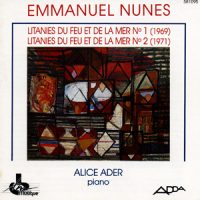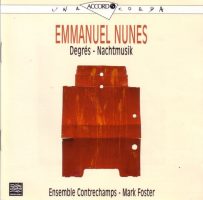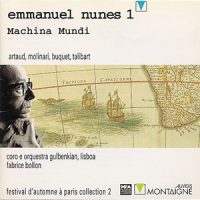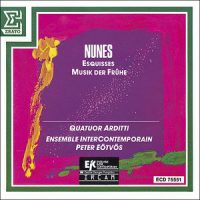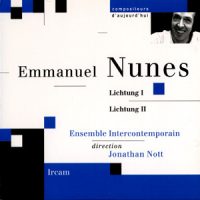Of Crags and Fissures
|
Dan Albertson [October 2016.] [To Kaixiang Yuan, with my gratitude for your initiatives.] As forewarned on his 75th birthday, here is a brief glimpse into the recorded output of Emmanuel Nunes (1941-2012), an exile from Portugal whose mature career was spent between France and Germany. Most of the discs are long gone, so good luck tracking them down. In fact, I avoided a few recent titles that are still possible to purchase, not wishing to spoil the fun for anyone, though the viola-centric disc on æon (AECD 0756) merits a listen. Why bother with such a survey? One simple reason: In an era in which the Muzio Clementis and Ignaz Pleyels of our time, i. e. those seeking only popular appeal, dominate serious music, for lack of a better term, Nunes is more essential than ever before. His music is ragged, rough and stern; often over-long, circuitous, patient, even delirious; informed by mathematics yet with an intuitive, organic posture. Whether or not it attains the ambitions that it has in mind is almost irrelevant. One needs to bear its faults and limitations in mind when contemplating its cumulative effect. Perfection is overrated. Were he a filmmaker, he would be Lav Diaz, not Béla Tarr. * * *
(1) Litanies du feu et de la mer I & II (1969-71). Alice Ader (pf). Adda 581095. Nunes partway between Eurotas and Vulcan. Excursions of register draped in an unceasing melancholy. Music seething at the cusp of an eruption, but seldom teetering over. This recording from the late 1980s has exquisite pacing; See Siang Wong (Guild GMCD 7318) is faster and less cogent. (2) Degrés (1965)*; Nachtmusik I (1977-78)**. Isabelle Magnenat (vn)*, Jürg Dähler (va)*, Daniel Haefliger (vc)*, Ensemble Contrechamps**, Mark Foster (cond.)**. Accord 204392. An early, almost episodic string trio in lapidary rather than fragmentary form, Degrés is a prelude to a mature masterpiece, Nachtmusik I, for English horn, bass clarinet, trombone, viola, and cello. Almost 34 mins. of earnestness that never wavers, it may be his most representative chamber piece. (3) Machina Mundi (1990-92). Pierre-Yves Artaud (fl, cb fl), Ernesto Molinari (cl, cb cl), Gérard Buquet (tuba), Claire Talibart (perc), Coro e Orquestra Gulbenkian, Fabrice Bollon (cond.). Montaigne Auvidis 782020. Not song-cycle, not cantata, not oratorio, not concerto, this work borders on incomprehensibility. A mélange of Os Lusíadas by Camões and snippets of the short poem A Mensagem by Pessoa, with recorded sounds, this work shows how unbridled his conceptions could be. Exultant and reclusive by turns, its endless breaking-down into subgroups ensures a tapestry of timbral variation. (4) Musik der Frühe (1980-86)*; Esquisses (1967, rev. 1980)**. Arditti String Quartet**; Ensemble Intercontemporain*, Péter Eötvös (cond.)*. Erato ECD 75551. A coupling that rightly places the masterpiece first, an austere and stately discourse for 18 players. The sketches for string quartet seem pale in comparison. (5) Lichtung I (1988-91); Lichtung II (1994-2000). Ensemble Intercontemporain, Jonathan Nott (cond.). Accord/Universal 472 964-2. No round-up could overlook his contribution to the field of music with live electronics. Not my Fach, for sure, and I have been critical of IRCAM elsewhere. I (clarinet + bass clarinet, French horn, trombone, euphonium, 4 percussion, and cello) is an arch of a sort, in which A gives way to B, with only synthesized sounds, before the instruments emerge transformed in C. Despite the technical wizardry, the electronic sounds are rather mundane and on the plunking end of the spectrum. II (2 clarinets, bass clarinet, French horn, alto trombone, euphonium, harp, 4 percussion, violin, viola, cello, and double bass) is longer yet more immediate: much more compelling. The electronic sounds are integral and the palette, not simply the instrumentation, broader. How this music sounds live, spatialized, is anyone’s guess. [III is later, from 2007, and has never appeared on a commercial disc. These works are in turn part of a broader cycle, La Création, whose combined duration must be north of six or seven hours and whose onset was, in fact, Nachtmusik I.]
[More Dan Albertson]
[More
Nunes]
[Previous Article:
String Theory 21: Mostly Viola(s)]
[Next Article:
Used Bin Troll Tweets T.]
|
